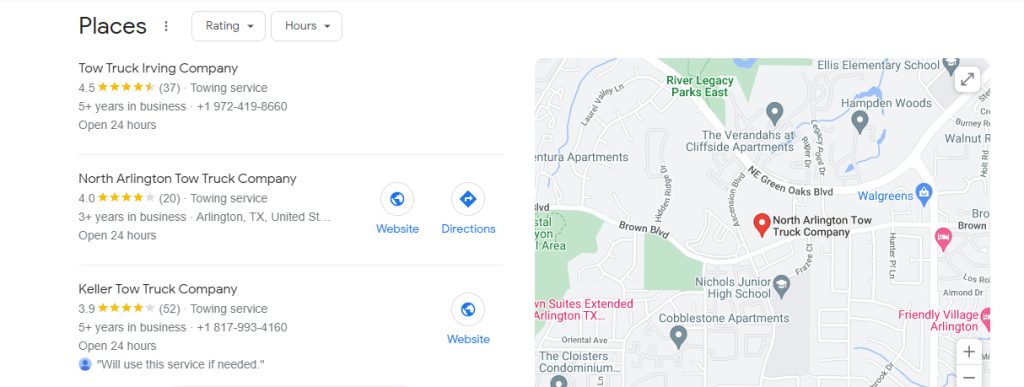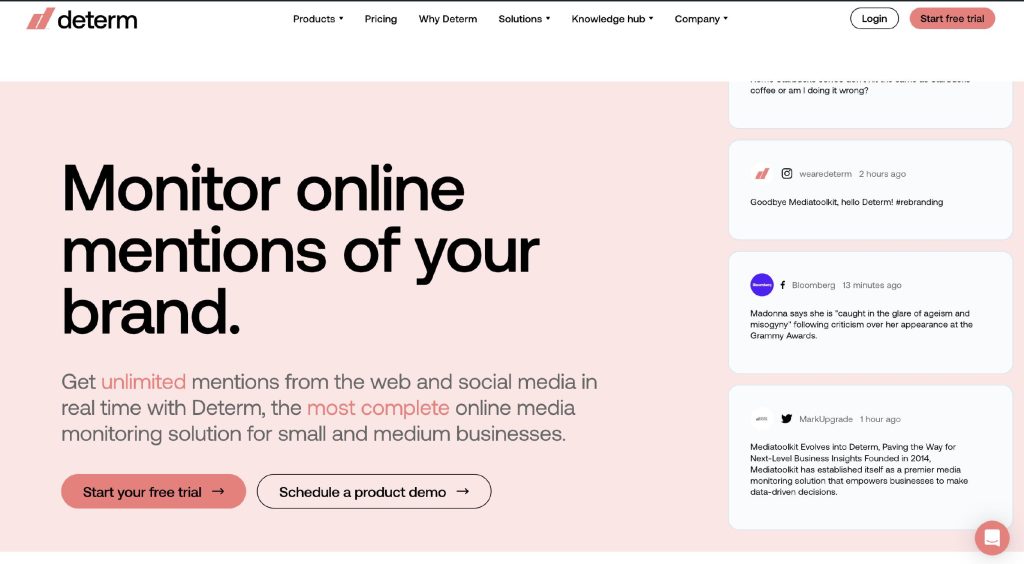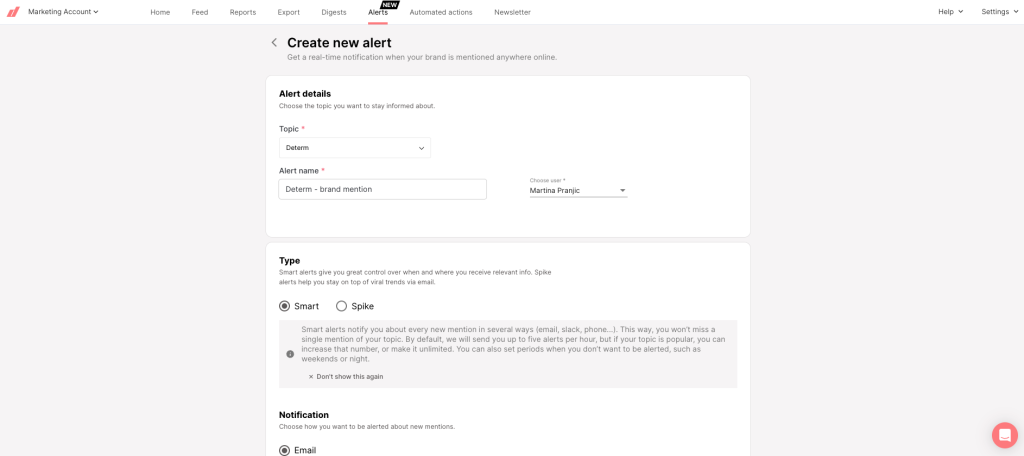Your business’s brand reputation is one of its most important assets. It can make or break your company. If you don’t know the public’s opinion of your brand, you could be missing out on key opportunities to improve.
Brand reputation management goes beyond setting up and running a website and posting engaging content. It requires ongoing monitoring to ensure that you are consistently staying on top of how people perceive your business.
💡 Read Brand Reputation 101: Monitoring, Analysis, and Management Tools
In this blog post, you’ll discover the key benefits of brand reputation monitoring and how businesses can effectively manage their brand reputation going forward.
What Is Brand Reputation Monitoring?
Brand reputation monitoring is the process of tracking public opinion and customer sentiment about your business, products, and services. It involves using feedback such as surveys, polls, reviews, comments, and social media posts, among others, to be aware of what people are saying about your business.
This data can help you identify areas where your brand is performing well and any issues that need to be addressed. By understanding how customers perceive your brand, you can make strategic decisions on how to better shape its reputation.
Read Ultimate Guide for CEO Reputation Management

Benefits of Brand Reputation Monitoring
Brand reputation monitoring offers several key benefits, as listed below.
1. Enhances credibility
Business credibility is the quality of being trusted by your target customers. It’s essential for customer loyalty and long-term success. One of the ways to appear more trustworthy is by having good reviews from past customers.
Remember, nearly 3 out of 4 consumers have more trust in businesses with positive reviews. By tracking what people are saying about your brand, you can quickly identify any negative sentiments and address them in time. This helps to build trust with potential customers and keep existing customers satisfied.
2. Improved customer experience
One of the main contributors to poor customer service is not understanding customer needs and expectations. If you don’t address potential problems quickly, you risk losing their business. In fact, according to Zendesk, 61 % of customers switch to a particular business’s competitor after just one poor customer experience.
With brand reputation monitoring, you can identify what your customers want and adjust your services to meet their needs. This could range from changing an interface on your website to changing the delivery time of products and services and so on.
Read How to Conduct Sentiment Analysis to Improve Customer Experience?
3. Higher ranking on search engines
Search engine algorithms are constantly evolving, with more and more focus being placed on user experience. How your previous customers perceive you determines whether new potential buyers can trust your business.
What happens is that your brand authority increases when you have more positive reviews from customers. Your business will rank higher in Google My Business listings than the competitors.
So, rather than focusing on how many reviews you have, you need to check the quality of the ratings you’re getting and act on them if needed.
Read 5 Key Steps in Brand Reputation Measurement
As an example, when you search something like “tow truck near me” on Google, you’re likely to first see businesses with the highest ratings first, as shown below:

4. More online visibility
Through brand reputation monitoring, you can determine who is talking about your company and on which platform they’re doing it. This information can then be used to improve your marketing and advertising efforts.
For example, if you see that a lot of people are talking about your brand on Facebook, you could focus your social media marketing efforts on that platform. What happens is that you’ll be able to reach a larger well-targeted audience, which could result in more conversions.
Read Top 5 Reputation Management Tools
5. More sales
The better your brand reputation is, the more sales you’ll make. Companies with poor public standing may have difficulty persuading customers to make a purchase.
With a good reputation, more people that come across your brand are more likely to purchase products or services from it simply because there’s trust. You’ll even benefit from word-of-mouth marketing without doing anything extra. So, having good feedback and reviews can help you increase your sales significantly.
How to Do Brand Reputation Monitoring
Now that we’ve gone over the key benefits of brand reputation monitoring, let’s take a look at how to do it right.
Set up a system for monitoring
The first step is to set up a system for brand reputation monitoring. This could involve using an automated monitoring solution such as Determ.
This tool will help you track any mentions of your brand online and alert you whenever something new pops up. All you need to do is set up an account and submit some of your brand’s keywords.
Remember, not all brand monitoring platforms are equal. When choosing a tool for monitoring your business online, pay attention to the features.
Some offer things like historical data, competitor comparison, and multiple users, while others may not. Also, pick a platform that suits your budget and test the features before committing to a paid plan if need be.
Read 3 Reasons Why You Should Do Brand Tracking

Read A Simple Guide to Corporate Reputation Management
Analyze customer feedback
Once you have the data, it’s important to analyze customer feedback. Feedback analysis will help you identify what people like and don’t like about your business and products or services.
Remember to consider things like volume and repetition in your analysis. If more people are saying your new product or service needs improvement and emphasize a specified area, it’s best to listen to their concerns.
Respond to customers promptly
When responding to customer feedback, make sure to do it promptly. This ensures that customers feel heard and respected. It’s also important to be transparent and honest in your responses.
One important thing when dealing with bad reviews is to stay calm and not respond based on emotion. Here are some things to include in a response to any negative feedback:
- Greet them in a personalized way, that is, by using their name
- Apologize for the poor experience and show empathy
- Explain the steps you are taking to address the issue
- Thank them for bringing it to your attention
- Offer to make it up to them if possible
Read Branded Keywords: How to Monitor Them and Why
Address issues quickly
When you detect any negative reviews or comments, it’s important to take action on them quickly. Try as much as possible to help a customer who left negative feedback resolve the issue. Depending on the situation, this could be done by:
- Replacing a product
- Offering discounts for future products
- Providing additional services
- Issuing a refund
- Working on the issue with your product or service
One of the most important things here is to receive the information about a negative review as soon as possible. And this is something that a feature called Alerts from Determ enables.

They are real-time notifications that you can receive whenever your brand is mentioned anywhere online. There are two types of alerts in Determ – spike and smart alerts. The difference between the two is in the type of notification you want to receive. If you’d like to receive it for every mention that matches specific filter critera, you’ll need Smart Alerts. If your aim is to receive notifications when there is an increase in the amount of mentions for a certain Topic of Folder, set up Spike Alerts.
Determ also provides the option of spike alert emails. It not only notifies you of trending topics but also highlights posts that may have triggered the increase in mentions. This feature provides immediate context, empowering you to take action or refine your strategies. In addition, the Spike Alert dashboard comprises a range of informative graphs and a concise Synthia summary for an in-depth analysis of the situation.
Read 4 Ways to Track Social With a Media Monitoring Tool
Stay on top of trends
Also, it’s important to stay on top of current trends. This will help you stay ahead of the competition and ensure that your brand is up-to-date with what customers are looking for. If you monitor industry trends, you can be the first to capitalize on new opportunities.

Mistakes to Avoid in Brand Reputation Monitoring
Let’s also look at some of the mistakes you should avoid when it comes to brand reputation monitoring.
Posting fake positive reviews
One of the biggest mistakes you can make is posting fake positive reviews. This is not only dishonest but it can also lead to customers losing trust in your business. If you’re caught posting fake reviews, you could also face some legal consequences.
Read 7 Ways to Protect Your Online Reputation
Focusing on a single platform
It’s important to monitor all the platforms and not just a single one. Remember, some people check Google reviews when they want to buy a new product. Others may use social platforms like Reddit or review sites such as Trustpilot to learn about the experience of buyers before them.
And so, focusing on a single platform can lead to missing out on valuable feedback and opportunities. Make sure to monitor different channels such as social media, review sites, forums, etc.
Forgetting to track the competition
Don’t forget to track your competitors as well. This will help you stay one step ahead of the competition by understanding their “mistakes” and making the necessary changes to your business. In other words, you can steal their customers by outdoing them in terms of customer service and quality.
Read Share of Voice: How to Track It and Why
Final Thoughts
Monitoring your brand reputation is essential for any business that wants to stay ahead of the competition and ensure customer satisfaction. It gives you insight into customer trends, behaviors, and preferences.
This data can be used to make informed decisions when it comes to product development and marketing strategies. By following the tips above, you can make sure that your brand always has a positive image and remains competitive.
Mike Stuzzi is an online entrepreneur who blogs at MikeStuzzi.com. He publishes helpful guides on starting online businesses, the best business tools to use, and his personal experiences on the site.


